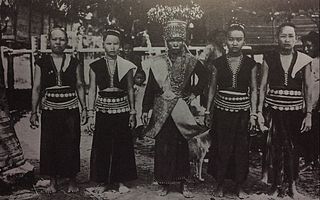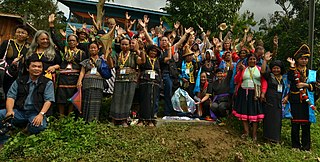
Dusun is the collective name of an indigenous ethnic group to the Malaysian state of Sabah of North Borneo. Collectively, they form the largest ethnic group in Sabah. The Dusun people have been internationally recognised as indigenous to Borneo since 2004 as per the United Nations Educational, Scientific and Cultural Organization (UNESCO).

The Kadazans are an ethnic group indigenous to the state of Sabah in Malaysia. They are found mainly in Penampang on the west coast of Sabah, the surrounding locales, and various locations in the interior.

The Ranau District is an administrative district in the Malaysian state of Sabah, part of the West Coast Division which includes the districts of Kota Belud, Kota Kinabalu, Papar, Penampang, Putatan, Ranau and Tuaran. The capital of the district is in Ranau Town. The landlocked district bordering the Sandakan Division to the east until it meets the Interior Division border. Ranau sits 108 km (67 mi) east of Kota Kinabalu and 227 km (141 mi) west of Sandakan. As of the 2010 Census, the population of the district was 94,092, an almost entirely Dusun ethnic community.

Tambunan is the capital of the Tambunan District in the Interior Division of Sabah, Malaysia. Its population was estimated to be around 35,667 in 2010. It is located 80 kilometres east of the state capital, Kota Kinabalu, 48 kilometres south of Ranau and 48 kilometres north of Keningau. At an average altitude of 750 metres, this valley town, which is part of the Crocker Range, experiences a mild tropical climate all year long. The valley is peppered with terraced paddy fields and 70 villages. The dense forests of bamboo around Tambunan town are a legacy of the British colonial period, during which an edict stated that 20 bamboo sprouts had to be planted for every bamboo cut.

The Kwijau or Kuijau are an indigenous ethnic group residing in Sabah, eastern Malaysia on the island of Borneo. The Kwijau tribe claim descent from the Nunuk Ragang settlers who intermarried and assimilated with the native Muruts. They reside in the Keningau district of the Interior Division within a 12-mile radius to the west and north of Keningau town centre. Their population was estimated at 7,910 in the year 2000. They are considered a sub-group of the Kadazan-Dusun, as their language is on the Dusunic branch of the Austronesian language family. About 20% of the population embrace the Christian faith in denominations of evangelical Christianity and Roman Catholicism with large significant Muslim minorities, the remainder are animist practicing the ancient belief system called Momolianism. They are known for performing the Magunatip, an east Malaysian dance very strongly influenced by the Philippine tinikling. Performed by the young men and women, the dance involves jumping steps that manoeuvre the dancer's feet in and out, so as not to get their feet trapped by 2 moving bamboo poles that are held by another pair of dancers, who beat the poles together and over a shorter length of wood or bamboo, creating an interesting rhythm.
The Rumanau are an indigenous ethnic group residing in Sabah, eastern Malaysia on the island of Borneo. They are known as the Lobu in the Keningau District near Lanas, and the Rumanau in the Masaum, Mangkawagu, Minusu areas of the Kinabatangan District along the Kinabatangan River, in Sandakan Division. Their population was estimated at 2,800 in the year 1991. They are a sub-group of the Kadazan-Dusun, although their language belongs to the Paitanic branch of the Austronesian language family.

Kadazan-Dusun are the largest ethnic group in Sabah, Malaysia, an amalgamation of the closely related indigenous Kadazan and Dusun peoples. They are also known as Mamasok Sabah, meaning "indigenous people of Sabah". Kadazan-Dusun tradition holds that they are the descendants of Nunuk Ragang. Kadazan-Dusun is recognised as an indigenous nation of Borneo with documented heritage by the United Nations Educational, Scientific and Cultural Organization (UNESCO) since 2004. Kadazan-Dusun is part of bumiputera group in Malaysia and has special rights concerning land, rivers, education and maintaining their own customs.
Coastal Kadazan, also known as Dusun Tangara, is a dialect of the Central Dusun as well as a minority language primarily spoken in Sabah, Malaysia. It is the primary dialect spoken by the Kadazan people in the west coast of Sabah especially in the districts of Penampang, Papar and Membakut.

The United Pasok Nunukragang National Organisation is a regional political party in Malaysia based in the state of Sabah. It was established in 1978. Before its deregistration, it was the oldest political party in Sabah that was currently still in existence. Despite being a party that maintains a Kadazan-Dusun ethnocentric platform, membership is opened to all ethnicities and the party's leadership has multi-ethnic representation.
Central Dusun, also known as Bunduliwan, is an Austronesian language and one of the more widespread languages spoken by the Dusun peoples of Sabah, Malaysia.

A Bobohizan or Bobolian is a high priestess, a ritual specialist and a spirit medium in Kadazan-Dusun pagan rites. The office of Bobohizan or Bobolian, is also the chief preserver of Momolianism, i.e. the philosophy and way of life of the Kadazan-Dusun people.

The United Pasokmomogun Kadazan Organisation was a Kadazan-Dusun-Murut (KDM) based political party in North Borneo and later Sabah at the time it became a state of Malaysia in the 1960s.
The Sabah Democratic Party was a political party based in Sabah, Malaysia. It was an ethnically-based party striving to voice the rights and advance the development of Kadazan-Dusun-Murut (KDM) populations of Sabah and the Orang Asli of Peninsular Malaysia.

Momolianism is a belief system of the Kadazan-Dusun people of Sabah.

Sabah is the third most populous state in Malaysia, with a population of 3,418,785 according to the 2020 Malaysian census. It also has the highest non-citizen population, at 810,443. Although Malaysia is one of the least densely populated countries in Asia, Sabah is particularly sparsely populated. Most of the population is concentrated along coastal areas, with towns and urban centers seeing the most population growth.

The Penampang District is an administrative district in the Malaysian state of Sabah, part of the West Coast Division which includes the districts of Kota Belud, Kota Kinabalu, Papar, Penampang, Putatan, Ranau and Tuaran. The capital of the district is in Penampang Town.
Datuk Jonathan bin Yasin is a Malaysian politician who has served as the Member of Parliament (MP) for Ranau since May 2018. He served as the Deputy Minister of Home Affairs II for the second term in the Barisan Nasional (BN) administration under former Prime Minister Ismail Sabri Yaakob and former Minister Hamzah Zainuddin from August 2021 to the collapse of the BN administration in November 2022 and the first term in Perikatan Nasional (PN) administration under former Prime Minister Muhyiddin Yassin and former Minister Hamzah from March 2020 to the collapse of the PN administration in August 2021. He is a direct member of the Gabungan Rakyat Sabah (GRS) coalition. He joined the Malaysian United Indigenous Party (BERSATU), a component party of the PN coalition after resigning from the People's Justice Party (PKR), a component party of the Pakatan Harapan (PH) opposition coalition. He later resigned from BERSATU but remained in GRS as direct member.

The United Progressive Kinabalu Organisation is a multiracial political party based in Sabah, Malaysia. The party was rebranded from its previous party's name, United Pasokmomogun Kadazandusun Murut Organisation using the same UPKO acronym; which was a widely known Kadazan-Dusun-Murut based party in 2019. The party had earlier been renamed once before in 1999 from its initial 1994 formation name of Sabah Democratic Party. In August 2021, UPKO has officially joined the Pakatan Harapan (PH) coalition as a component party.

Tenghilan is a small town and mukim under the administration of the Tamparuli minor district office. It is located in the Tuaran District of the West Coast Division of Sabah, Malaysia. The Tenghilan area is centered around a small town of the same name located near the road that connects Kota Kinabalu and Kota Belud. In 2010, its population was estimated at 203 inhabitants, mostly of Kadazan-Dusun origin. The town, which covers about 400 hectares of land, is located about 17 km northeast of Tuaran, and 25 km southwest of Kota Belud.















